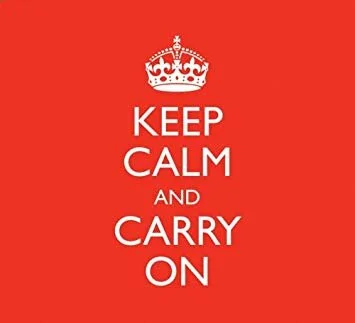“Keep Calm and Carry On” was produced by the British government in 1939 on the eve of World War II. The desire was to encourage the populace to be self-disciplined, courageous and calm in the face of adversity. Today we find ourselves in unchartered territory with a global pandemic and life literally turned upside down overnight. While some may see the governmental measures taken to be an overreaction, the church must not remain silent when there is real fear and anxiety in our homes and communities surrounding this crisis. In many respects, we find ourselves in a war-time environment that has not been seen since World War II. My prayer and hope is that you find these suggestions helpful in ministering to your local congregations. The situation seemingly changes by the hour, but let us remain vigilant and keep our eyes focused on “Jesus, the source and perfecter of our faith.” (Heb. 12:2)
1. This is not a time to fear but to demonstrate faith and courage in the midst of crisis. (2 Timothy 1:7; Philippians 4:6-7)
2. This is a time for patience and calm. (Galatians 5:22; Ephesians 4:22; Philippians 2:13-15)
3. This is a time to seriously consider not meeting for corporate worship for a couple of weeks.
• Let everyone submit to the governing authorities, since there is no authority except from God, and the authorities that exist are instituted by God. So then, the one who resists the authority is opposing God’s command, and those who oppose it will bring judgment on themselves. (Romans 13:1-2 CSB)
▸ President Trump is recommending not to meet in groups larger than 10.
▸ Governor Pritzker has mandated based on CDC recommendations that groups of 50 or more not gather through March 30 which coincides with statewide school closures.
• Love your neighbor as yourself. (Matthew 22:39 CSB)
▸ Loving our neighbor sometimes requires us to look out for their well-being.
▸ If meeting together could harm those who are most at risk such as older adults, perhaps for a time we need to forsake gathering together because of our love for our brothers and sisters.
4. If you choose not to meet, consider adapting your ministry to serve people better and adjusting your giving methods. (Matthew 5:13-16)
• Can we share the message of Jesus on-line? (e.g. Facebook Live)
• What are some alternative ways of giving? (e.g. On-line giving, mail it to the church, write the check and save it until corporate gathering resumes)
• What will pastoral ministry and contact look like? (e.g. phone calls and texts to members, visits, especially to the elderly)
• How can we serve our community during this time of need? (e.g. collecting and distributing food, hygiene items, etc., working with schools, community ministry partners and other agencies to be salt and light during this dark time)
• How else can we meet? (Consider small group home ministry, Acts 2:46)
5. If you choose to meet, consider what precautions and adjustments you might need to make.
• If you are sick or even symptomatic, recommend that your folks stay home, especially the elderly. This includes the pastor as well.
• If you have a greeting time, consider not shaking hands but do elbow bumps.
• For the offering, consider having the ushers stand at the front or back of the sanctuary to receive the offering rather than pass the plate.
• Make hand sanitizer available if you do not already.
6. Whatever decision you reach, communicate it clearly with your people.
RESOURCES
RENNOVATE CORONA VIRUS RESOURCES FOR CHURCHES
A THEOLOGICAL FRAMEWORK FOR ADJUSTING CHURCH PRACTICE
COVID-19: ENCOURAGEMENT FOR PASTORS IN THE MIDST OF PANDEMIC
COVID-19: HOW SHOULD WE THEN COMPLY?
WHAT IS THE FEDERAL GOVERNMENT’S PUBLIC HEALTH RESPONSE TO COVID-19?

